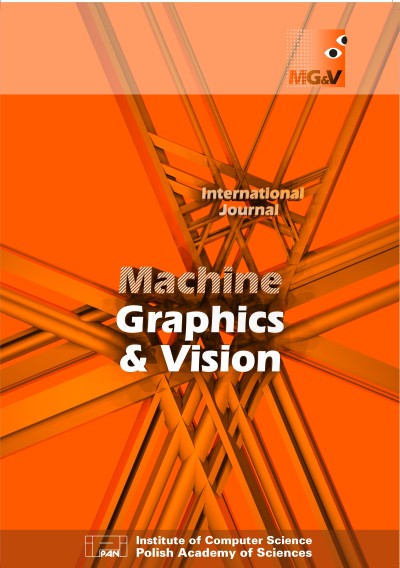Main Article Content
Medical rehabilitation treatment is of vital importance to all those who have experienced limb impairments due to unexpected accidents or geriatric dysfunctions. However, due to extensive government savings, the access to regular rehabilitation services is becoming increasingly difficult. This paper presents a low-cost, immersive augmented reality passive medical rehabilitation system exploiting depth-based limb joint tracking, supported with the Microsoft Kinect controller. Depth-based augmented reality solutions, though hardware affordable, suffer from miscellaneous problems. Duality of reference coordinate systems for RGB and depth sensors entails imprecision of limb joint positions measurement, whereas reliable limbs rehabilitation and their motility supervision require precise joints positioning and reliable visual feedback from the system. The present solution proposes the use of visual markers overlaid on the patient's image as an interface layer and two complementary sensors for depth-based spatial limbs tracking. It organizes the visual aspect of the rehabilitation stand, helps to immerse the patients into the rehabilitation process by providing them with a way to follow their achievements, while also monitoring the correctness of exercise performance.
Article Details
Dega W., Ortopedia i rehabilitacja. PZWL, Warszawa, 1983.
Weiss M., Rehabilitacja – zagadnienia wybrane. In R. B. W. Brühl, editor, Vademecum lekarza ogólnego, PZWL, 1974.
Rodrigues R., Huber M., Lamura G. (eds.), Facts and figures on healthy ageing and long-term care. European Centre for Social Welfare Policy and Research, Vienna, 2012.
Sagan A., Panteli D., Health systems in transition. World Health Organization, 2012.
Białokoz-Kalinowska J., Zagrożenia zdrowotne wynikające z nieracjonalnego korzystania z komputera przez dzieci i młodzież. Dziecko i media elektroniczne, Białystok, 2005.
Griffiths M. Technological addictions. Clinical Psychology Forum, 76:14-19, 1995. (Crossref)
Totilo S., Natal recognizes 31 body parts, uses tenth of Xbox 360. Computing Resources Kotaku, Gawker Media, 2010.
Jack D., Boian R. et al. A virtual reality-based exercise program for stroke rehabilitation. In Proc. 4th Int. ACM Conf. Assistive Technologies, ser. Assets ’00, New York, USA, 2000. (Crossref)
Labelle K. Evaluation of kinect joint tracking for clinical and in-home stroke rehabilitation tools. Ph.D. dissertation, Undergraduate Program in Computer Science Notre Dame, Indiana, 2011.
Chaves M. Development and evaluation of a Kinect based motor rehabilitation game. In SBC – Proc. SBGames, 2012.
Chang C.-Y., Lange B. et al. Towards pervasive physical rehabilitation using Microsoft Kinect. In Proc. 6th Int. Conf. Pervasive Computing Technologies for Healthcare, San Diego, CA, May 2012. (Crossref)
Lange B. B., Rizzo S. Markerless full body tracking: Depth-sensing technology within virtual environments. In Interservice/Industry Training, Simulation, and Education Conference, 2011.
Lange B., Chang C.-Y. et al.Development and evaluation of low cost game-based balance rehabilitation tool using the Microsoft Kinect sensor. In Engineering in Medicine and Biology Society, EMBC, 2011 Annual International Conference of the IEEE, 2011. (Crossref)
Chang Y.-J., Chen S.-F., Huang J.-D. A kinect-based system for physical rehabilitation: A pilot study for young adults with motor disabilities. Research in Developmental Disabilities, 32(6):2566-2570, 2011. (Crossref)
Barry J. R., Malinovsky M. R., Client motivation for rehabilitation: A review. Rehabilitation Research Monograph Series, University of Florida, 1970.
Arvers I. Serious games. Digitalarti Mag, 4:24-25, 2009.
Schönauer C., Pintaric T., and Kaufmann H. Full body interaction for serious games in motor rehabilitation. In Proc. 2nd Augmented Human International Conference, ser. AH ’11, New York, NY, USA: ACM, 2011. (Crossref)
Lange B., Koenig S. et al. Interactive game-based rehabilitation using the Microsoft Kinect. In Virtual Reality Short Papers and Posters (VRW 2012), IEEE, 2012. (Crossref)
Hondori H.M., Khademi M., A review on technical and clinical impact of Microsoft Kinect on physical therapy and rehabilitation. Journal of Medical Engineering, 2014:846514. https://doi.org/10.1155/2014/846514, 2014. (Crossref)
Davaasambuu B. E., Chiang C.-C. A Microsoft Kinect based virtual rehabilitation system. In Proc. 5th Int. Conf. FITAT 2012, 2012.
Downloads
- Jakub Walczak, Adam Wojciechowski, Improved gender classification using Discrete Wavelet Transform and hybrid Support Vector Machine , Machine Graphics & Vision: Vol. 25 No. 1/4 (2016)





